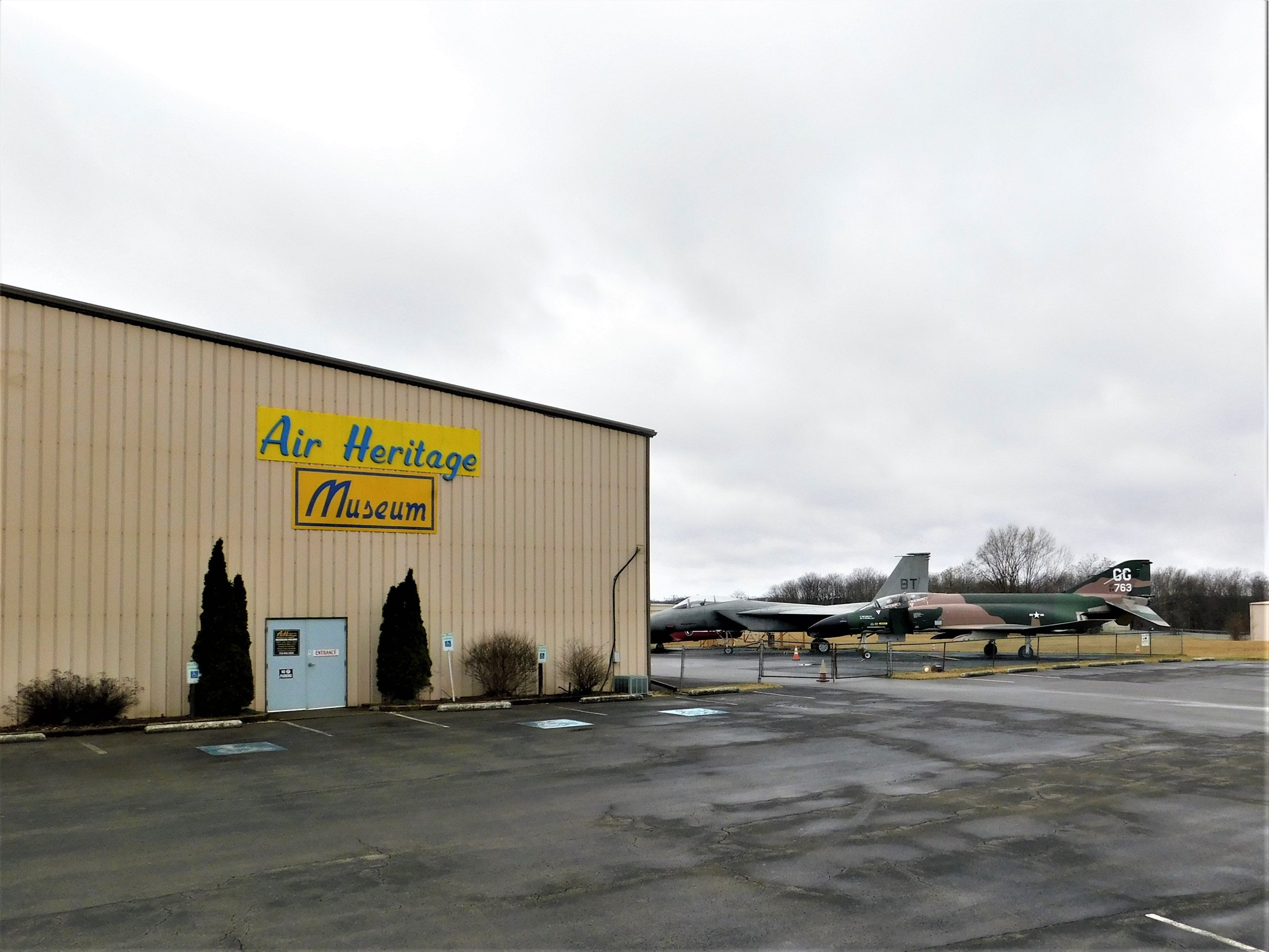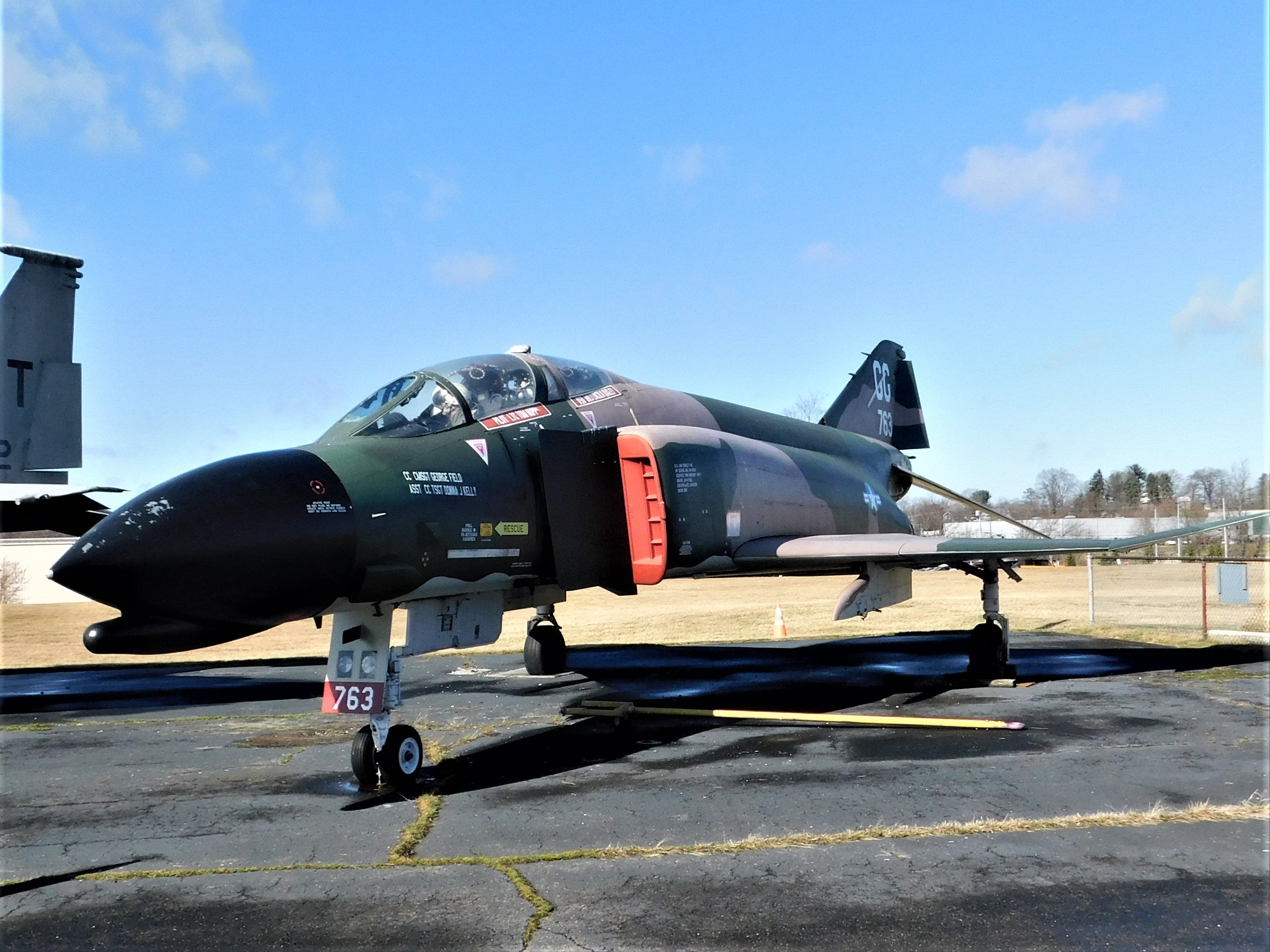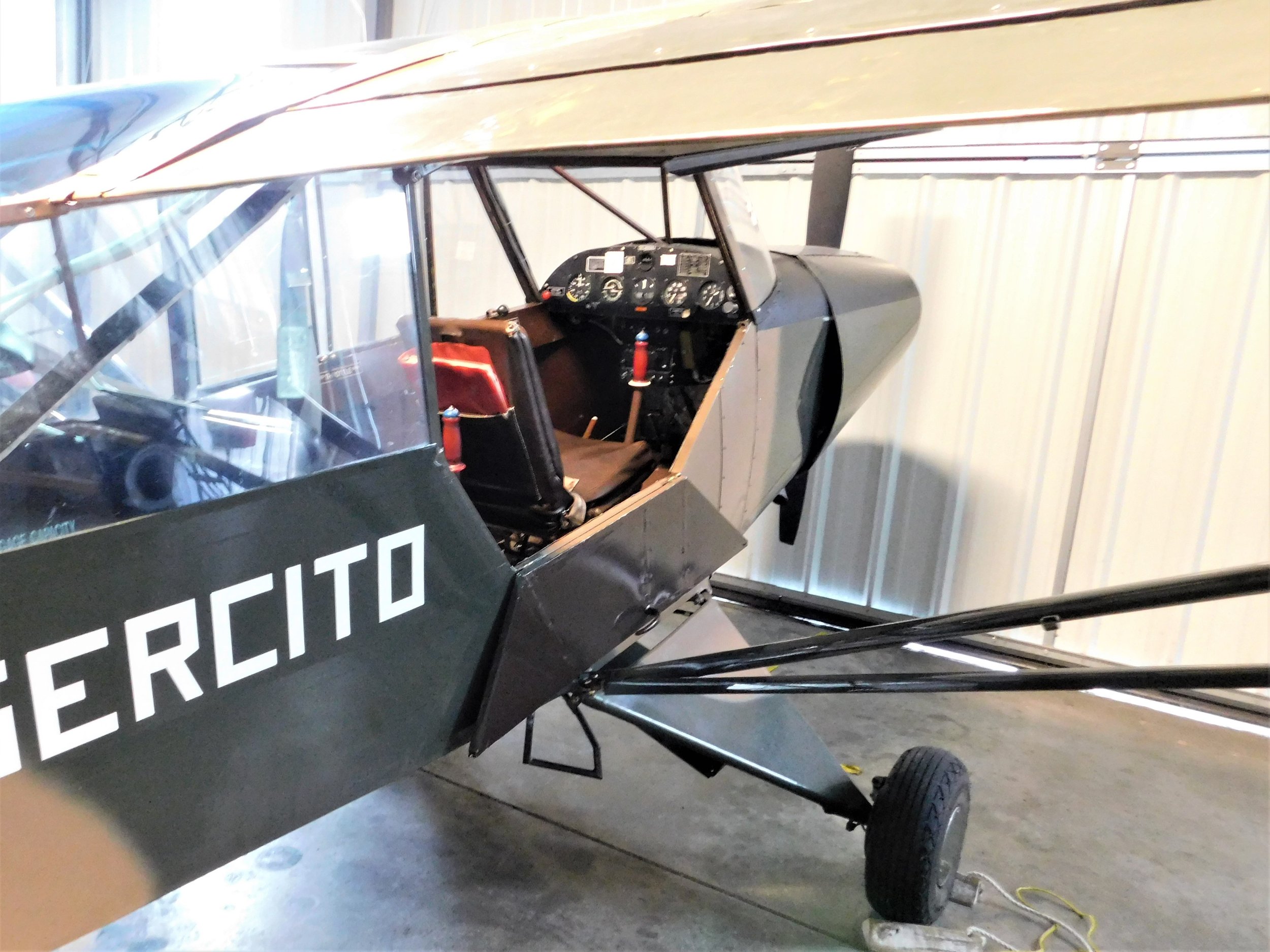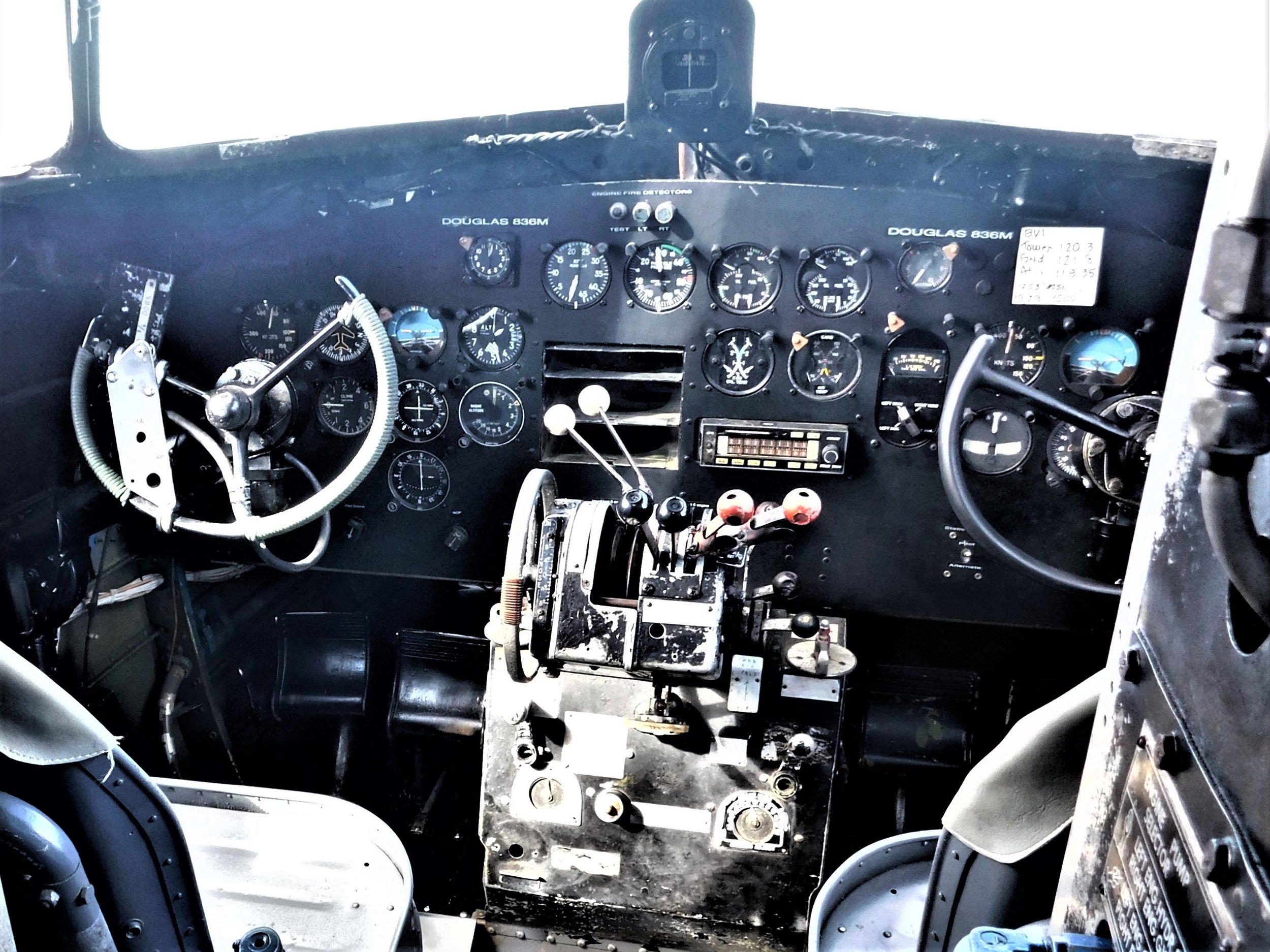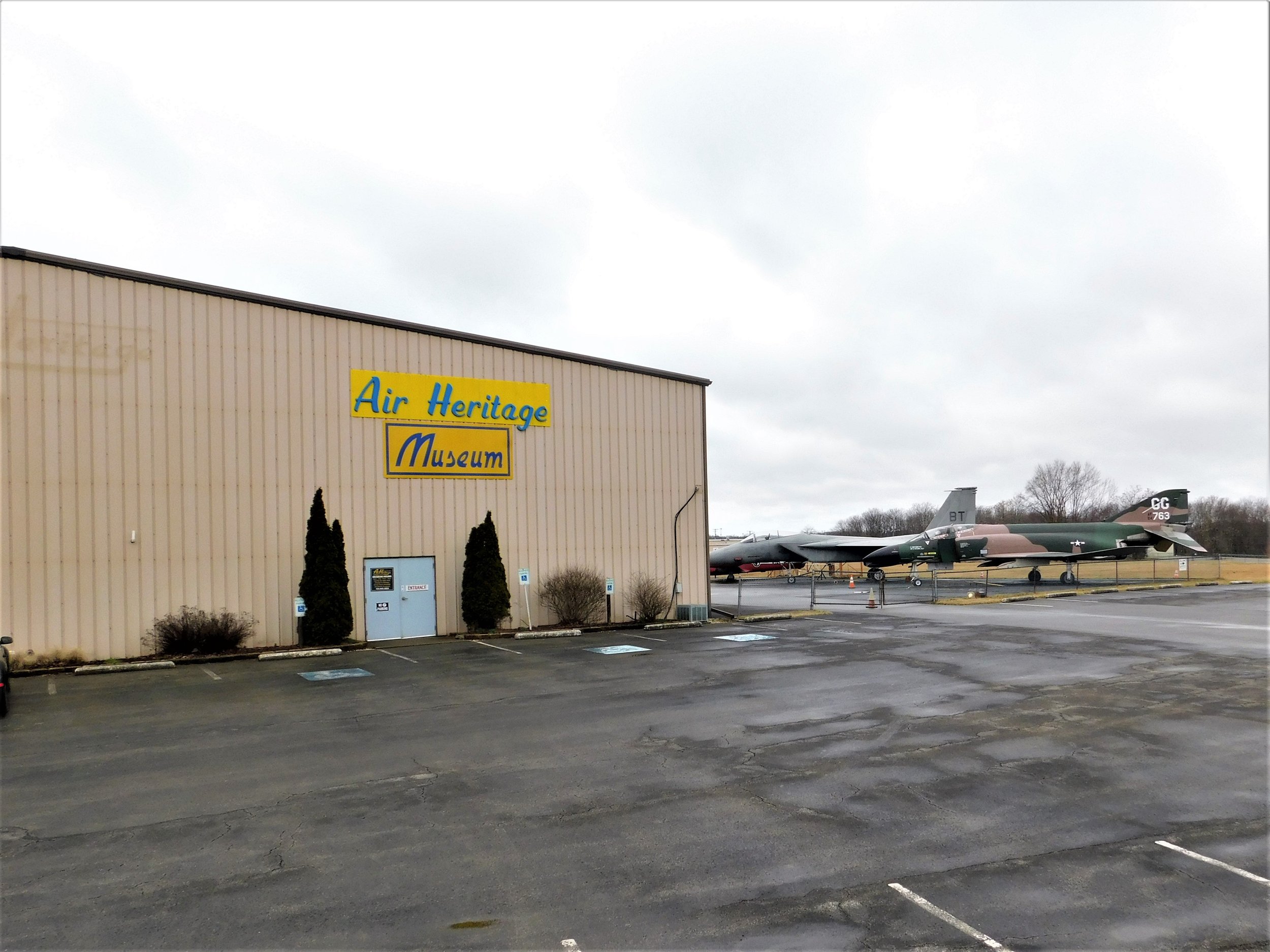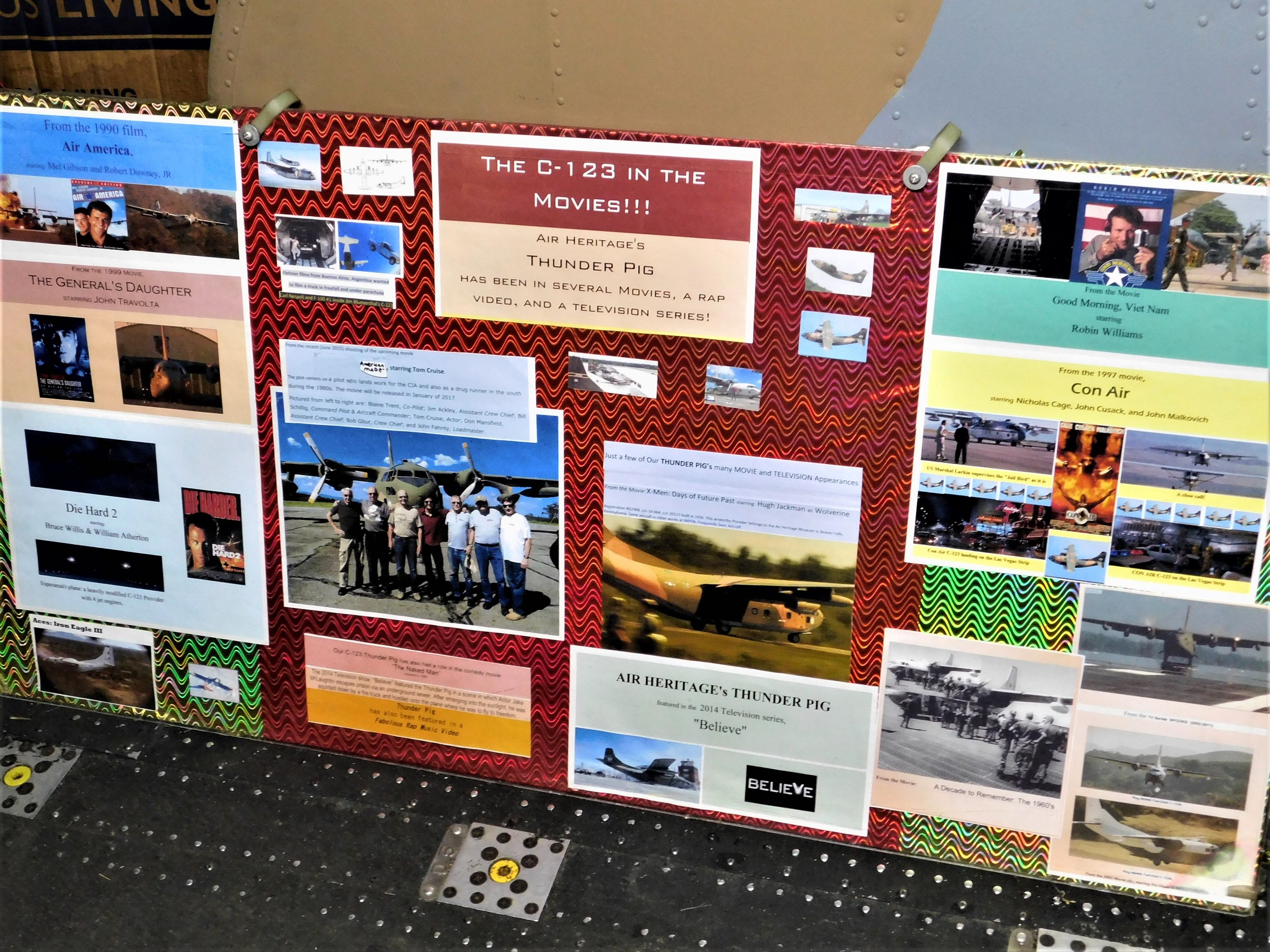Air Heritage Museum
Issue 41 A visit to the Air Heritage Museum in Beaver Falls, PA
The final German offensive push of World War II took place from 16 December 1944 to 28 January 1945 in the Ardennes, a densely wooded area between Luxembourg and Belgium. It became known as The Battle of Bulge. The operation began with a surprise attack by German forces. The attack was successful for a number of reasons including; overconfidence of Allied Forces, bad weather, lack of intelligence information, and over extended supply lines. American troops, including the 101st Airborne and the 10th Armored Division, bore the brunt of the attack. By 21 December, the town of Bastogne was surrounded and cut off from reinforcements and supply lines. When General Anthony McAuliffe, commander of the 101st, was informed that the Germans were demanding his surrender, he delivered his famous one-word response “Nuts!”. Over the next five days, the surrounded units were resupplied with air drops and their perimeter held.
One of the units that resupplied the 101st airborne during the siege was the 435th Troop Carrier Group of the 75th Troop Carrier Squadron, based at RAF Welford, about 50 miles west of London. A C-47 assigned to the 435th, 44-48716, flew missions to Bastogne on 24 December and 26 December, dropping ammunition on both days. That C-47B, restored to the same condition it was in during the missions in 1944, is still flying today. It bears its original name “Luck of the Irish” and is on display at the Air Heritage Museum, in Beaver Falls PA.
Transcription of the original hand-written logs of “Luck of the Irish” from 1944
Founded in 1983, The Air Heritage Museum is one of the many great smaller aviation museums that are really worth seeking out and visiting. Air Heritage may be small, but it has plenty of interesting things to see. The main hangar has a mix of flying aircraft, static aircraft, and aircraft under restoration. The ramp behind the hangar has static and flying aircraft on display. I started my visit on the ramp.
On the side of the museum there is an eclectic grouping on static display: an F-4 Phantom II, an F-15 Eagle, and a Jet Provost T3. Let’s start with the Hunting Percival Jet Provost, a plane that is rarely seen in this country.
Following WW II, when the Labour Party came to power, Great Britain embarked on a process of nationalizing industry. In various forms, transportation, steel production, telecom, energy production, and the automobile industry were nationalized. In 1960, English Electric (manufacturer of the Canberra), Vickers-Armstrong (Viscount), Hunting Percival Aircraft (Provost), and the Bristol Aeroplane Company (Britannia) were merged by government mandate into the British Aircraft Corporation. The first product of the new British Aircraft Corporation was the BAC 1-11, a design that came originally from Percival Aircraft. The BAC 1-11 was a successful airliner that was operated by many airlines- including Braniff, Allegheny, Mohawk, and US Air.
Another early product of BAC was the Jet Provost, a jet trainer and light attack aircraft. The design was developed from the Percival Provost, a piston powered trainer.
The piston Provost was a successful trainer with 461 built. The cockpits of the two trainers were very similar, making transition from the prop version to the jet relatively simple. The Jet Provost was also successful, with 734 being built between 1958 and 1967.
One of only three on display in the U.S., this Jet Provost came to the museum in a unique way. A gentleman with a farm in Western Pennsylvania had various business ventures in England. At one point he was owed a sum of money and was given an offer of this plane for payment. He accepted the offer and somehow got it to his farm, where it sat in a field for many years. Eventually, a member of the Air Heritage Museum noticed the plane, contacted the owners, and it was donated to the Museum by the family of Mr. Burt Todd.
The McDonnell Douglas F-15 Eagle first flew in 1972 and entered service in 1976. The design of the Eagle was in part a result of combat experiences in Vietnam. This particular Eagle, AF 76-012, is an F-15A. It was originally assigned to the 36th Fighter Wing stationed at Bitburg, Germany, and it flew in Operation Desert Storm. After the A model became obsolete, it was sent to the Air Force sheet metal school at Robins AFB in Georgia. Many holes were punched in the skin and students were given experience making “patch for combat” repairs. After the museum acquired the aircraft and trucked it to Beaver Falls, the first order of business was to remove all the patches to give the skin an esthetic appearance. This F-15 has been a part of the museum since 2009.
The McDonnell Douglas F-4 Phantom II was a mainstay fighter for both the Air Force, Navy, and Marines during the Vietnam War. It was partly the experience of F-4 crews in Vietnam that led to the development of the F-15. The Phantom II was the most produced supersonic fighter ever, serving in all branches of the U.S. military as well as in the military of numerous other countries. With its high speed (Mach 2.2+) and heavy weapons load, the Phantom II was expected to outclass any adversary. The F-4 was originally designed without an internal gun, as aerial combat was presumed to take place at higher speeds and higher altitudes, with missiles. The Vietnam War soon proved this to be wrong, as the Soviet built MiGs were lighter and more maneuverable. Due to this experience, the F-15 was designed for one mission, Air Superiority, and has excelled in that role for the USAF and its allies, with over 100 victories worldwide and no losses. The C and D models are a significant improvement over the A and B models, and the F-15 today remains a very capable partner to the F-22 Raptor. The F-15E Strike Eagle, developed from the F-15D, is a very effective deep interdiction aircraft, replacing the F-111. The F-16 C/D and the F-18 E/F Super Hornet are very capable air to air fighters, but they were designed from the beginning as dual-role air to air and ground attack aircraft. While the F-15 and F-22 would be expected to be superior long-range interceptors, in a close-in "dogfight", all four are extremely capable. Who would win? Ask someone who flies them!
Phantom II wings prior to restoration Photo courtesy of Air Heritage Museum
The Air Heritage Museum recently completed a full restoration of this McDonnell Douglas F-4C Phantom II.
Short Brothers Sherpa C-23B
The history of Short Brothers aircraft goes back to 1897 when Eustace and Oswald Short bought a used coal-gas filled balloon. They soon began manufacturing hot air balloons for sale near Brighton England. By 1908, the brothers had heard reports of Wilbur Wright’s flying displays in Le Mans, France and realized that their balloon business would soon be a thing of the past. They decided to build a plane of their own design, while at the same time obtaining the rights to manufacture Wright aircraft in England. The first Wright Flyer that they built was for C.S. Rolls, co-founder of Rolls-Royce (in 1910, Rolls died in a crash of the plane, becoming the first aviation casualty in England). During World War I, the Short Brothers began manufacturing seaplanes. By 1937, they had moved their operation to Belfast, Northern Ireland, where they became known for large, long-range, flying boats. The company was purchased by Bombardier in 1989.
In the 1960s Shorts had found a niche producing small turboprop transport aircraft. The C-23B in the museum is a military version of the well-known Shorts 330. The Sherpa made a very practical military transport for both cargo and personnel and was acquired by the military of a number of nations, in addition to the U.S. Air Force and Army. Its large square fuselage and wide rear ramp made for easy loading and it had a great capability on short and unimproved runways. The PT-6 turboprop engines provided excellent reliability. During the heyday of turbo-prop commuter aircraft, the Short Sky Van could be seen taxiing at busy major airports along with Saabs, Merlins and Twin Otters. It was not unusual for an airline pilot to be told by ground control to “follow the pair of Shorts”. And the Short was often referred to as “the box the King Air came in”. All joking aside, the Short Skyvan was a very successful plane, with many still in use today.
The Fairchild C-123 Provider first flew in 1949 as a product of Chase Aircraft, an airframe that evolved from a Chase Aircraft glider design. That company was unable to handle production of the plane and the contract eventually went to Fairchild Industries, who produced the C-123 in their Hagerstown, MD plant. The C-123 went into service in 1955 with Air Force logistic squadrons as well as with the Coast Guard for search and rescue.
The 123 is another aircraft that served throughout the Vietnam War. The original C-123 was powered by two Pratt & Whitney R-2800-99W Double Wasp engines. By the early 1960s, Fairchild had upgraded the Provider by adding two General Electric J85-GE-17 jet engines. The power and the short field capability of the C-123 made it a very useful aircraft in Southeast Asia for a variety of missions (including by the CIA). A total of 307 of the type were built, with the C-123B being the main production version. Of this total, 83 B models were converted to the C-123K, with the turbojets added.
The museum’s C-123K, serial # 54-664, was manufactured in 1956 in Hagerstown MD. Originally assigned to the 513th Troop Carrier Group at Sewart AFB, TN (now closed and re-named Smyrna/Rutherford County Airport), it also served with active duty and reserve squadrons at a number of other Air Force bases. Its final assignment was at Rickenbacker AFB in Ohio. Declared surplus in 1981, 54-664 was flown to the bone yard at Davis Monthan AFB in Arizona. In April 1994, a crew from the Air Heritage Museum flew to Davis Monthan to evaluate the C-123 for acquisition. The goal was to obtain a flying aircraft. The crew found the Provider in pretty good condition and they had it flying in just two weeks. The trip home included a blown tire which took a lot of work and effort to replace. By the middle of May, the C-123 had arrived at Beaver County Airport.
The C-123 is now totally restored and participates in air shows every summer. The Provider is affectionally named “Thunder Pig”, a name given by the 911th Airlift Wing based at Greater Pittsburgh Airport when they flew the C-123.
Thunder Pig has also appeared in several movies, including “American Made” starring Tom Cruise. In the movie, which is based on a true story, Cruise plays a TWA pilot turned drug runner, turned informant. The film is an interesting look at events of the 1980s, including the Iran/Contra affair. The museum’s C-123 is a central part of the second half of the movie and appears in many scenes, both on the ground and in the air. “American Made” is definitely worth a rental.
Tom Cruise in front of Thunder Pig in a still from “American Made”, Universal Pictures
Thunder Pig in flight. A still from “American Made”, Universal Pictures
The North American T-28 Trojan had a long history of service, primarily as a Navy basic trainer. Like many Naval Aviators, I made my first carrier landings in a T-28C on the USS Lexington. This particular T-28, BuNo 138311, was released from Navy duty in 1984 and was transferred to the Alaskan Division of Natural Resources, where it continued to serve for almost 20 years. In 2002, it was flown to Ft. Bliss Texas and declared surplus. The museum acquired the Trojan in 2003 and it arrived at Air Heritage in 2004. At that time, it had a civilian paint job and it has since been restored, and returned to its Naval Air Training Command paint scheme.
Working museums handle their static displays in various ways- some, like the Air Power Museum in last month’s issue, place their display cases in the hangar, among the aircraft. Others, like the Air Heritage Museum, have a separate display area. This collection of artifacts, models, uniforms, and general items of aviation interest is very well organized and is arranged in a pleasing way.
Each case and display is artfully curated and you can spend plenty of time learning the history attached to each item, or just wander through enjoying the ambiance.
The museum has a second hangar across the ramp. There are a number of interesting items stored in the hangar, including several of Air Heritage’s flying aircraft.
In 1949, Piper Aircraft introduced an upgraded version of their iconic Piper J-3 Cub (itself developed from the Taylor E-2 Cub). The changes to the new model, the Piper PA-18 Super Cub, included the addition of an electrical system, flaps, and a more powerful engine. These advances gave the Super Cub excellent short field capability and it was soon modified for a number of back country and agricultural uses. The great flexibility of the Super Cub also made it attractive as a military aircraft. The military version, designated the L-21, was delivered to over 20 countries around the world.
The Super Cub in the museum is an L-21B which was built in 1954 and originally delivered to the Italian Army at the Viterbo Airbase, north of Rome. The L-21 was bought under the Mutual Defense Assistance Program (MDAP), which was developed after WWII to counter the growing threat of the Soviet Union. Unlike the WWII Lend-Lease program, the equipment under this plan was never expected to be paid for by the foreign country. This Super Cub served in the Italian military until 1979, when it was returned to the U.S. The museum acquired it in 1987. Museum volunteers restored the Super Cub to its original Italian military colors and they now maintain it in flying condition.
Most aviation museums have work going on. Whether it is upgrading or refurbishing current displays, the work is pretty constant. Many museums also have aircraft that need to be restored before they are added to the museum’s displays. In most cases, the restoration process is out of sight to visitors. The Air Heritage Museum has an on-going restoration taking place in the main hangar, giving visitors a unique opportunity to see the restoration in progress, and even to speak with volunteers who are doing the detailed work.
Funk Model B-75-L
In 1933, brothers Howard and Joe Funk designed and built a two-seat cabin class aircraft, the Funk Model B. To power their creation, they built their own engine, a modification of a Ford automobile engine. Flight tests were successful and, by 1939, the brothers had formed the Akron Aircraft Company. They began building their Model B, this time with a Lycoming engine. In 1941 the company moved to Kansas and was renamed the Funk Aircraft Company. Production ended due to WWII and just one Funk, designated a UC-92, entered Army service during the war. The company started up again after the war with the model B-85-C, but sales were slow and production stopped in 1948. A total of 380 Funk aircraft were built.
A restored Funk Model B Photo courtesy of the Air Heritage Museum
This Funk B-75-L was donated to the Museum by Dave Reid in 2009. Museum personnel did a thorough inventory and determined that the plane is mostly original and complete. The full restoration has been underway ever since.
Let’s finish our tour of the Air Heritage Museum with some more about the C-47 in the opening story.
A friend of mine and fellow US Air pilot, Dave Messersmith, led the team that restored “Luck of the Irish”. He now oversees maintaining the iconic military transport and is the C-47s primary pilot. I asked Dave to tell us a little bit about what it is like to fly a Sky Train. Here’s Dave reply (Dave’s “day job” was flying an Airbus)-
“I’ll start with arrival at the airplane.
Airbus – enter aircraft, grab a cup of coffee from the galley, enter cockpit, start-up the computers.
Sky Train – Start external walk-around, remove drip pans, remove control locks (except rudder, if windy), pull propellers thru checking for hydraulic locks, visually check fuel and oil, if hydraulics are pressurized and gear is Down/Locked, remove gear pins. On the way ‘uphill’ to the cockpit, note hydraulic system quantity and accumulator pre-charge.
Take a seat.
Airbus – seat is infinitely adjustable, fore, aft, up, down. Same for the rudder pedals. Also, seat is covered in a nice comfy sheep skin. Put your coffee in the convenient cup holder.
Sky Train – seat is covered in cold vinyl. About five positions fore/aft, up/down, rudders in/out. I have yet to find a good position of the seat/rudder pedals for my 6’1” 200 lb. frame. No matter how I set the seat, my knees are in conflict with the yoke.
Fast forward to engine start.
Airbus – Basically starts itself. Computers control all of the normal/abnormal functions of the start process. Sit back and enjoy the ‘show’.
Sky Train – Position Fire Guard. Pre-oil for 30-seconds. Fuel boost pump – ON, Engage starter and count up to 12 blades, checking for hydraulic lock. Then Ignition – Both, Mixture – Rich. Stick head out window and look for raw fuel running from Blower Drain, indicating fuel being supplied. Watch for indication of start and look for any indication of fire. Back inside – oil pressure?, Boost pump – OFF, check engine driven fuel pump. Keep the idle at 1000 rpms or less until oil temperature reaches a minimum of 40 degrees.
On to the Run-up.
Airbus - “what’s a run-up?”
Sky Train – 1700 Rpm, cycle the 75-year-old Hamilton-Standard’s, check the feathering pumps, verify propeller governor operation. Advance throttles individually to Field Barometric Pressure, about 29” of manifold pressure, and verify charted RPM is achieved. Verify magneto operation and engine gauges.”
Thanks Dave! This is just an excerpt from what Dave wrote- read the complete version at the end of the blog.
The history of the Douglas C-47/DC-3 is well know and there are many examples flying today. Organizations, like the Air Heritage Museum, who maintain these planes in flying condition are very important to keeping their history alive. Likewise, visiting and supporting these museums is very important in helping the effort.
As mentioned earlier, the logs from WWII for this Sky Train are preserved in the museum. This C-47 did not arrive in England in time to participate on D-Day, but its missions during the Battle of the Bulge and Operation Varsity are commemorated on the fuselage with various battle ribbons. During Operation Varsity, the single largest air drop of troops and supplies during a single day, it towed two Waco CG-4 gliders.
“Luck of the Irish” was acquired by the museum in 2013. At the time, the history of the C-47 was not known. In researching the plane, one of the combat aircraft commanders, Captain Edward Wilson Frome, was contacted. He was 95 at the time and he and his daughter provided much information about the history of the plane, including the complete war diary of the 75th Troop Carrier Squadron. Air Heritage is the first civilian operator of the plane. After its military service, it worked for many years as a mosquito sprayer for the State of Florida.
———————————————————————
The Air Heritage Museum does an excellent job of preserving aviation history and providing a welcoming atmosphere. It is most certainly worth a visit.
————————————————————————
A Special thanks to Tom Gargaro, John Peterson and Dave Messersmith who showed me around the museum and assisted in my research. Thanks also to my brother Mike who always edits the blog, but also did some research on the F-15 for this one.
Thanks also to my great friend, Tom Accamando, who made the trip to Beaver County with me. Thanks Tom!
———————————————————————
To learn about what to do in the local area, museum hours and costs as well as books to read and other interesting odds and ends, keep reading! At the end you will find a photo gallery of the entire museum.
PLANNING YOUR VISIT
Open 10:00 AM – 5:00 PM Monday – Saturday
Sunday by appointment only.
Closed major holidays
Museum entry and parking is free
FLYING IN
The museum is located on Beaver County Airport (KBVI). Runway 10/28 is paved and is 4,501’ X 100’ with RNAV, LOC and VOR approaches to each runway. There are two full service FBOs on the field: Air Quest Aviation and Moore Aviation. You can park on the ramp in front of the museum.
WHERE TO EAT
The Chippewa Shopping Center is nearby, with several restaurants and fast-food places. We ate at the Z Pub and Diner. It has excellent food and service, with a pleasant sports-themed atmosphere.
SUGGESTED READING
“All I have learned, I learned from books.” Abraham Lincoln.
When writing about the C-47, I decided to read up on the battle of the Bulge and I came across Martin King’s The Battle of the Bulge: The Allies' Greatest Conflict on the Western Front. The book is extensively researched and very readable. King draws on many personal interviews and it is an excellent book.
Regular readers know I enjoy reading about the history of Pan Am. I recently read a book from a different perspective- that of a stewardess for Pan Am. Come Fly the World by Julia Cooke is an interesting look at the world-wide operations of Pan Am in the 60s and 70s. It includes a detailed description of R & R flights that Pan Am flew during the Vietnam War. Although the descriptions of Pan Am operations are interesting, the book is essentially about that little-known aspect of the war in Vietnam. Most certainly an interesting historical view.
MUSEUM WEBSITE
HOW TO SUPPORT THE MUSEUM
This is a new section to the blog. I have always recommended support for these great museums, but this will be a more direct way to offer your support. These museums, especially the smaller ones, survive on many hours of volunteer work, but they also have many ongoing expenses and every small donation helps. Here is the link to support the Air Heritage Museum (501(c)(3) tax deductible organization):
https://www.facebook.com/airheritage/fundraisers
Please note, this blog is not directly connected to any museum and 100% of any donation goes only to the museum.
This section was suggested by reader Bob Walter. Thanks Bob!
UP NEXT
New England Air Museum, Windsor Locks CT.
MUSEUMS ARE WHERE YOU FIND THEM
This segment is dedicated to finding interesting aviation artifacts that are in public view- but not in an aviation museum. If you see one send a photo!
Sion airport (LSGS) in Switzerland is located in the beautiful Rhone Valley. The approach and departure are spectacularly scenic. A Swiss Air Force base is located on the South side of the airport and, like on many military bases, there is an aircraft displayed on a pedestal.
Interestingly, this photo of the F-4 wasn’t taken in Sion, it was taken in a Gulfstream 650 simulator. I recently had the pleasure of training Steve Taylor, retired chief pilot for Boeing and President of the Museum of Flight in Seattle. Steve had flown into Sion and wanted to take a closer look at the departure and arrival routes. It definitely added some interest to the sim session!
PHOTO GALLERY
Click on photo to enlarge
Here is the full post from Dave-
“Flying the 1940s Douglas DC-3 – from the perspective of an ‘Airline Guy”Back in 2018 I had the honor of leading a restoration team bringing ‘Luck of the Irish’, a 1943 C-47D, back from its well-worn life as a mosquito sprayer, to her former glory as a WW2 hero/veteran.
Additionally, I get the privilege of flying this piece of history!
Here is an overview of life with a DC-3 ‘Sky Train’, vs my usual Airbus A320
I’ll start with arrival at the airplane.
Airbus – enter aircraft, grab a free cup of coffee from the galley, enter cockpit, start-up the computers.
Sky Train – Start external walk-around, remove drip pans, remove control locks (except rudder, if windy), pull propellers thru checking for hydraulic locks, visually check fuel and oil, if hydraulics are pressurized and gear is Down/Locked, remove gear pins. On the way ‘uphill’ to the cockpit, note hydraulic system quantity and accumulator pre-charge.
Take a seat.
Airbus – seat is infinitely adjustable, fore, aft, up, down. Same for the rudder pedals. Also, seat is covered in a nice comfy sheep skin. Put your coffee in the nice cup holder.
Sky Train – covered in cold vinyl. About five positions fore/aft, up/down, rudders in/out. And remember, these cockpits were designed in 1938 for a pilot that had never heard of ‘fast-food.’ I have yet to find a position of the seat/rudder pedals where my 6’1” 200 lb. frame doesn’t allow for a good seat position, that doesn’t put my knees in conflict with the yoke.
Fast forward to engine start.
Airbus – Basically starts itself. Computer controls all of the normal/abnormal functions of the start process. Enjoy the ‘show’.
Sky Train – Position Fire Guard. Pre-oil for 30-seconds. Fuel boost pump – ON, Engage starter and count up to 12 blades, checking for hydraulic lock. Then Ignition – Both, Mixture – Rich. Stick head out window and look for raw fuel running from Blower Drain, indicating fuel being supplied. Watch for indication of start and look for any indication of fire. Back inside – oil pressure?, Boost pump – OFF, check engine driven fuel pump. Keep the idle at 1000 rpm’s or less until oil temperature reaches a minimum of 40 degrees.
On to the Run-up.
Airbus - “what run-up?”
Sky Train – 1700 Rpm, cycle the 75-year-old Hamilton-Standard’s, check the feathering pumps, verify propeller governor operation. Advance throttles individually to Field Barometric Pressure, about 29” of manifold pressure, and verify charted RPM is achieved. . Verify magneto operation and engine gauges.
Taxi to the runway.
Airbus – graduated nose wheel steering by ‘tiller’ based upon speed. Great brakes.
Sky Train – NO steering. Tailwheel is either ‘locked’ straight, or full swivel. Use differential power to help turning or to counteract the yaw caused by winds. Brakes? Adequate, but not impressive.
Time for Takeoff. (That only took about 15-20 minutes to get here)
To be continued….
Time for Takeoff.
Airbus – Set ‘FLEX or TOGA’ and that little wheel on the front makes it easy to steer. At Vr rotate into pitch command bars. Activate Autopilot at you leisure.
Sky Train – Taxi into position. Don’t forget to lock the tailwheel. Apply partial power and see if Mr. Hamilton and Standard want to cooperate today. Advance power to 48” MAP.. Let PM (pilot monitoring) set final setting – you have directional control issues to worry about!, and yes, you can manually over-boost the engines (aka engine change). Correct for P-factor, torque, gyroscopic procession, and slipstream effect…. Having fun yet? Raise tail to decrease lift while awaiting Vr, 84 KTS. A lightly loaded C-47 will fly at about 55 KTS if you leave the tail low… Bad news is that Vmca is 76 KTS… that’s Ok, unless you loose one of your 75+ year-old engines. Rotate at 84 KTS and start thinking about a power reduction – don’t forget that there is a one-minute limit on TO power. Call for ‘Gear-up’ and watch your copilot go thru the five-step process to retract the gear… Call for After Take-off Checklist.
Cruise.
Airbus – Ask Flight Attendant ‘what’s for lunch..’
Sky Train – Set Cruise Power. Check Cylinder Head Temperatures. Adjust Cowl Flaps. Select ‘Auto Lean.’ Monitor, monitor, monitor…
Descent and Approach.
Airbus – Think about lunch. Slow to 250 below 10,000’. Program arrival/approach into FMC (Flight Management Computer). Watch the automation ‘show’ fly the airplane..
Sky Train – Reduce power to 2050 RPM and 20.5” MAP. NEVER let propeller drive engine RPM due to design ‘issues’ with lubrication of the Main bearing. Arrive at downwind leg below Flap speed, select ¼ flaps… then gear Down and call for Before Landing Checklist. If you plan your energy management correctly, you should not have to change the power setting (20/20) until the flair. Vref is 90 knots – not much different than a Baron…. Just a lot heavier on the controls. Remember, this aircraft was designed in 1938.
Landing.
Airbus – Autothrust handles all of the work. ‘Arrive at runway’, aircraft will align itself with runway at touchdown…. No fear of ground looping or brake issues.
Sky Train – Wheel landings are preferred because they are easier on the tail. Adjust longitudinal axis to align with runway, use bank to cancel-out the drift. Focus on keeping the aircraft on the runway… Don’t apply brakes too aggressively, they have a tendency to fade. At taxi speed, unlock the tailwheel lock. Use differential thrust to help with directional control while taxiing.
Parking.
Airbus – “Is that a Five Guys?
Sky Train – Set brakes. Check Cylinder Head Temperature. Check Magnetos ‘OFF’ position momentarily to verify that P-leads are functioning. Shut-down right engine so you can verify left engine hydraulic pump and vacuum pump operation. Move mixture control slowly to Idle Cutoff and check Idle-Strength setting. Allow engine to cool and then close Cowl Flaps. Install gear pins and control locks. Examine engines for ‘major’ oil leakage. Now, finally, think about food…….” Dave Messersmith.
Issue 41, Copyright©2023, Pilot House Publishing, LLC. All rights reserved.
Except where noted, all photos by the author
